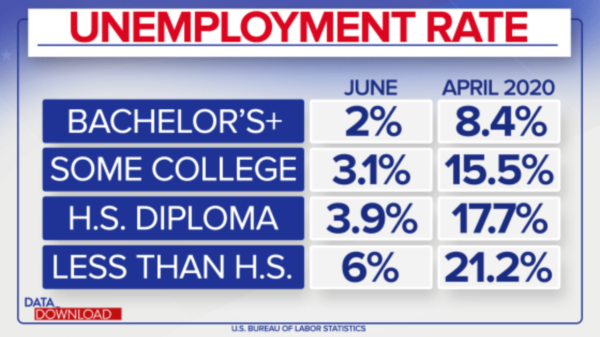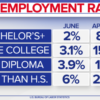
By Justin Fox
In March, the unemployment rate for Black Americans fell to 5% from 5.7% the month before. This was the lowest Black unemployment rate ever recorded in the Bureau of Labor Statistics monthly data, which goes back to 1972. It wasn’t really an all-time low — a 1953 BLS study estimated that the Black unemployment rate had been 4.6% the previous year, and even lower during World War II — but the 1.8 percentage-point gap in March between the Black unemployment rate and the white rate of 3.2% may have been (it was 2.2 percentage points in 1952).
These milestones understandably received a lot of attention. When the Black unemployment rate fell to 4.7% in April, and the Black-white gap contracted to just 1.6 points, that received attention, too. (So did the fact that the Black employment-population ratio was higher than the white ratio in March for the first time on record, although this was partly because only 16.7% of Black non-institutionalized civilians 16 and older (the denominator in the employment-population ratio) are 65 or older while 23.6% of whites are. The prime age (25-54) Black-white employment-population gap never dropped below 3.1 percentage points.
Then the Black unemployment rate jumped to 5.6% in May and 6% in June, generating headlines of a less-positive sort, while the white rate barely budged. In July, it fell back to 5.8%, pretty much where it was in February.
What are we to make of this roller coaster? Right now, the best answer seems to be “not much.”
The Black unemployment rate is much more volatile than the white one. So volatile that there’s a good chance its headline-generating fall and rise this spring was just statistical noise. There’s also a chance that it conveyed some information — maybe Black unemployment truly did bottom out in April and will continue its fitful rise in coming months, in which case it will likely be followed by an overall unemployment increase. But it’s important to keep in mind that while even small movements in the headline unemployment rate usually convey information, month-to-month changes among subgroups often don’t.
The unemployment statistics are derived from the Current Population Survey, which the Census Bureau conducts every month on behalf of the BLS. As surveys go, the CPS is gigantic. Remember those New York Times-Siena College poll results about the presidential horse race and other topics that were released a couple of weeks ago? They were based on the opinions of 1,329 registered voters. The CPS contacts 60,000 households every month, collecting information on about 110,000 individuals.
As a result, the estimated sampling errors are much smaller for the CPS than for political polls. The margin of error in that New York Times-Siena poll was plus or minus 3.67 percentage points. The CPS is designed, according to the BLS, to ensure that “assuming a national unemployment rate of 6%, an over-the-month change of roughly 0.2 percentage points be statistically significant at the 90% level of confidence.” In July, the error margin for the overall 3.5% unemployment rate was plus or minus 0.09 percentage points, and the cutoff for statistical significance in the change from June was 0.18 points.
It is this level of precision that allows for tools like the “Sahm rule” recession indicator, based on economist (and Bloomberg Opinion columnist) Claudia Sahm’s observation that every time since 1970 that the three-month moving average of the national unemployment rate has risen 0.5 percentage points or more above its low during the previous 12 months, a recession has occurred.
But there’s still some error even in the headline unemployment rate, which is why the Sahm rule uses three-month averages, and that error grows when one turns to smaller groups such as Black Americans, who make up 13% of the labor force. Apply the Sahm rule to the Black unemployment rate, and you get more than 40 recessions since 1972 instead of the actual seven. A couple of those were sustained increases that speak of the more tenuous status of Black workers, whose unemployment rose amid modest slowdowns that had little effect on the overall unemployment rate, but most appear to be statistical noise.
While error margins aren’t published alongside the unemployment rates and other jobs data from the CPS, the BLS provides the formulas and other information needed to calculate them as well as a monthly table showing whether changes in a selected set of indicators were statistically significant or not. According to the formula, the 90% confidence-level margin of error for Black unemployment in July was plus or minus 0.34 percentage points. According to the table, the one-month, six-month, nine-month and 12-month changes in the rate were not statistically significant, but the three-month change was.
That was the change since April, when the Black unemployment rate bottomed at 4.6%. But the 90% confidence level means we should expect the margin of error to be exceeded in one month out of 10, plus all these calculations assume that the people surveyed represent an unbiased random sample of the population in question. The BLS offers a list of 10 sources of “nonsampling error” that could also affect the accuracy of its labor market numbers, and one in particular has grown in significance in recent years: The CPS response rate is down from 90% a decade ago to around 70% so far this year. Adjustments are made to counteract differences between respondents and nonrespondents that may skew the results, but they’re not perfect.
Paying too much heed to the error inherent in economic statistics cannot only be boring but misleading, given that sampling errors are distributed along a bell curve with the actual value much likelier to be close to the reported number than at the edges of the margin of error. My Bloomberg colleague Joe Weisenthal used to facetiously warn right before the BLS released the monthly jobs numbers that “if you tweet about revisions, margin for error or anything like that you will be blocked and reported for abuse.” I’m mostly on board with that attitude.
But when there’s a sudden, sharp break from the trend line for an already noisy statistic — one that isn’t brought on by some obvious cause such as, say, a pandemic — it is definitely worth pausing and questioning whether it’s for real. It’s also worth doing what one can to reduce the noise by averaging data over multiple months and taking the long view.
The big picture is that the Black-white unemployment gap fell to new lows just before the pandemic, and even with the increase after this spring’s record-breaking dip remains quite narrow by historical standards. There’s a cyclical component to the gap — that is, it grows during recessions — which is why any increase merits attention as a possible harbinger of bad times, which if history is any guide would be much worse for Black workers than white ones.
But the fact that the gap is now markedly smaller than during the boom times of the late 1990s is a welcome sign of possible structural change because of reduced racial discrimination in the job market or some other cause. (Some economists look instead to the ratio of Black unemployment to white unemployment, which has shown less improvement. But that’s an odd metric given that it reliably falls during recessions, precisely when times are worst for Black workers, and even now it is markedly lower than in most past expansions.)
Right now, that seems to be the main story to be found in the unemployment data for Black Americans. If all goes well, it still will be a few months from now.
Justin Fox is a Bloomberg Opinion columnist covering business, economics and other topics involving charts.









You must be logged in to post a comment Login